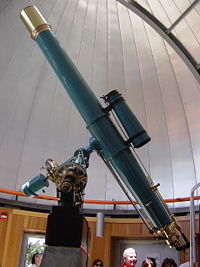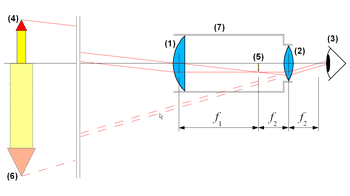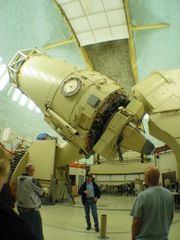Optical telescope
2008/9 Schools Wikipedia Selection. Related subjects: Engineering; Space (Astronomy)
An optical telescope is a telescope which is used to gather and focus light mainly from the visible part of the electromagnetic spectrum, for directly viewing a magnified image, making a photograph, or collecting data through electronic image sensors.
There are three primary types of optical telescope: Refractors ( Dioptrics) which use lenses, Reflectors ( Catoptrics) which use mirrors, and Combined Lens-Mirror Systems ( Catadioptrics) which use lenses and mirrors in combination (for example the Maksutov telescope and the Schmidt camera).
History
The earliest known working telescopes appeared in 1608 and are credited to three individuals, Hans Lippershey and Zacharias Janssen, spectacle-makers in Middelburg, and Jacob Metius of Alkmaar also known as Jacob Adriaanszoon (although there are claims that Leonard Digges, an English mathematician and surveyor, constructed one in 1570s). Galileo Galilei made his own telescope in 1609 after hearing about Hans Lippershey's design, calling it at first a "perspicillum," and then using the terms "telescopium" in Latin and "telescopio" in Italian (from which the English word derives). Galileo is generally credited with being the first to use a telescope for astronomical purposes. (The telescope was first used to spot ships.) Galileo's telescope consisted of a convex object lens and a concave eye lens, which is universally called a Galilean telescope (still used in camera viewfinders and in simple " Galilean binocular" designs). Later, Johannes Kepler described the optics of lenses (see his books Astronomiae Pars Optica and Dioptrice), including a new kind of astronomical telescope with two convex lenses (a principle often called the Keplerian Telescope).
How it works
The basic scheme is that the primary light-gathering element, the objective (1) (the convex lens or concave mirror used to gather the incoming light), focuses that light from the distant object (4) to a focal plane where it forms a real image (5). This image may be recorded, or viewed through an eyepiece (2) which acts like a magnifying glass. The eye (3) sees an inverted magnified virtual image (6) of the object.
Inverted images
Most telescope designs produce an inverted image at the focal plane. These are referred to as inverting telescopes. In astronomical telescopes the inverted view is normally not corrected, since it does not affect how the telescope is used. In terrestrial telescopes such as Spotting scopes, monoculars, and binoculars, prisms (e.g. Porro prisms) or a relay lens between objective and eyepiece are used to invert the image once more to a correct orientation. There are telescope designs that do not present an inverted image such as the Galilean refractor and the Gregorian reflector. These are referred to as erecting telescopes.
Design variants
Many types of telescope fold or divert the optical path with secondary or tertiary mirrors. These may be integral part of the optical design ( Newtonian telescope, Cassegrain reflector or similar types), or may simply be used to place the eyepiece or detector at a more convenient position. Telescope designs may also use specially designed additional lenses or mirrors to improved image quality over a larger field of view.
Angular resolution
Ignoring blurring of the image by turbulence in the atmosphere ( atmospheric seeing) and optical imperfections of the telescope, the angular resolution of an optical telescope is determined by the width of the objective, termed its " aperture" (the primary mirror, or lens.) The Rayleigh criterion for the resolution limit αR (in radians) is given by
- αR = 1.22λ / D,
where λ is the wavelength and D is the aperture. For visible light (λ = 550 nm), this equation can be rewritten:
- αR = 138 / D.
Here, αR denotes the resolution limit in arcseconds and D is in millimeters. In the ideal case, the two components double stars can be split even if separated by slightly less than αR. This is taken into account by the Dawes limit
- αD = 116 / D.
Essentially; the larger the aperture, the better the angular resolution
It should be noted that the resolution is NOT given by the maximum magnification (or "power") of a telescope. Telescopes marketed by giving high values of the maximum power often deliver poor images.
For large ground-based telescopes, the resolution is limited by atmospheric seeing. This limit can be overcome by placing the telescopes above the atmosphere, e.g., on the summits of high mountains, on balloon and high-flying airplanes, or in space. Resolution limits can also be overcome by adaptive optics, speckle imaging or lucky imaging for ground-based telescopes.
Recently, it has become practical to perform aperture synthesis with arrays of optical telescopes. Very high resolution images can be obtained with groups of widely-spaced smaller telescopes, linked together by carefully controlled optical paths, but these interferometers can only be used for imaging bright objects such as stars or measuring the bright cores of active galaxies. Example images of starspots on Betelgeuse can be seen here.
Focal length and f-ratio
The focal length determines how wide an angle the telescope can view with a given eyepiece or size of a CCD detector or photographic plate. The f-ratio (or focal ratio, or f-number) of a telescope is the ratio between the focal length and the aperture (i.e., diameter) of the objective. Thus, for a given aperture (light-gathering power), low f-ratios indicate wide fields of view. Wide-field telescopes (such as astrographs) are used to track satellites and asteroids, for cosmic-ray research, and for surveys of the sky. It is more difficult to reduce optical aberrations in telescopes with low f-ratio than in telescopes with larger f-ratio.
Light-gathering power
The light-gathering power of an optical telescope is directly related to the diameter (or aperture) of the objective lens or mirror. Note that the area of a circle is proportional to the square of the radius. A telescope with a lens which has a diameter three times that of another will have nine times the light-gathering power. Larger objectives gather more light, and more sensitive imaging equipment can produce better images from less light.
Imperfect images
No telescope can form a perfect image. Even if a reflecting telescope could have a perfect mirror, or a refracting telescope could have a perfect lens, the effects of aperture diffraction could still not be escaped. In reality, perfect mirrors and perfect lenses do not exist, so image aberrations in addition to aperture diffraction must be taken into account. Image aberrations can be broken down into two main classes, monochromatic, and polychromatic. In 1857, Philipp Ludwig von Seidel (1821–1896) decomposed the first order monochromatic aberrations into five constituent aberrations. They are now commonly referred to as the five Seidel Aberrations.
The five Seidel aberrations
- Spherical aberration
- The difference in focal length between paraxial rays and marginal rays, proportional to the square of the aperture.
- Coma
- A most objectionable defect by which points are imaged as comet-like asymmetrical patches of light with tails, which makes measurement very imprecise. Its magnitude is usually deduced from the optical sine theorem.
- Astigmatism
- The image of a point forms focal lines at the sagittal and tangental foci and in between (in the absence of coma) an elliptical shape.
- Curvature of Field
- The Petzval curvature means that the image instead of lying in a plane actually lies on a curved surface which is described as hollow or round. This causes problems when a flat imaging device is used e.g. a photographic plate or CCD image sensor.
- Distortion
- Either barrel or pincushion, a radial distortion which must be corrected for if multiple images are to be combined (similar to stitching multiple photos into a panoramic photo).
They are always listed in the above order since this expresses their interdependence as first order aberrations via moves of the exit/entrance pupils. The first Seidel aberration, Spherical Aberration, is independent of the position of the exit pupil (as it is the same for axial and extra-axial pencils). The second, coma, changes as a function of pupil distance and spherical aberration, hence the well-known result that it is impossible to correct the coma in a lens free of spherical aberration by simply moving the pupil. Similar dependencies affect the remaining aberrations in the list.
The chromatic aberrations
- Longitudinal Chromatic Aberration
- As with spherical aberration this is the same for axial and oblique pencils.
- Transverse Chromatic Aberration (Chromatic Aberration of Magnification)
Optical Research telescopes
Nearly all large research-grade astronomical telescopes are reflectors. Some reasons are:
- In a lens the entire volume of material has to be free of imperfection and inhomogeneities, whereas in a mirror, only one surface has to be perfectly polished.
- Light of different colors travels through a medium other than vacuum at different speeds. This causes chromatic aberration.
- Reflectors work in a wider spectrum of light since certain wavelengths are absorbed when passing through glass elements like those found in a refractor or catadioptric.
- There are technical difficulties involved in manufacturing and manipulating large-aperture lenses. One of them is that all real materials sag in gravity. A lens can only be held by its perimeter. A mirror, on the other hand, can be supported by the whole side opposite to its reflecting face.
Most large research telescopes can operate as either a Cassegrain telescope (longer focal length, and a narrower field with higher magnification) or a Newtonian telescope (brighter field). They have a pierced primary mirror, a Newtonian focus, and a spider to mount a variety of replaceable secondary mirrors.
A new era of telescope making was inaugurated by the Multiple Mirror Telescope (MMT), with a mirror composed of six segments synthesizing a mirror of 4.5 meters diameter. This has now been replaced by a single 6.5 m mirror. Its example was followed by the Keck telescopes with 10 m segmented mirrors.
The largest current ground-based telescopes have a primary mirror of between 6 and 11 meters in diameter. In this generation of telescopes, the mirror is usually very thin, and is kept in an optimal shape by an array of actuators (see active optics). This technology has driven new designs for future telescopes with diameters of 30, 50 and even 100 meters.
Relatively cheap, mass-produced ~2 meter telescopes have recently been developed and have made a significant impact on astronomy research. These allow many astronomical targets to be monitored continuously, and for large areas of sky to be surveyed. Many are robotic telescopes, computer controlled over the internet (see e.g. the Liverpool Telescope and the Faulkes Telescope North and South), allowing automated follow-up of astronomical events.
Initially the detector used in telescopes was the human eye. Later, the sensitized photographic plate took its place, and the spectrograph was introduced, allowing the gathering of spectral information. After the photographic plate, successive generations of electronic detectors, such as the charge-coupled device (CCDs), have been perfected, each with more sensitivity and resolution, and often with a wider wavelength coverage.
Current research telescopes have several instruments to choose from such as:
- imagers, of different spectral responses
- spectrographs, useful in different regions of the spectrum
- polarimeters, that detect light polarization.
The phenomenon of optical diffraction sets a limit to the resolution and image quality that a telescope can achieve, which is the effective area of the Airy disc, which limits how close two such discs can be placed. This absolute limit is called the diffraction limit (or sometimes the Rayleigh criterion, Dawes limit or Sparrow's resolution limit). This limit depends on the wavelength of the studied light (so that the limit for red light comes much earlier than the limit for blue light) and on the diameter of the telescope mirror. This means that a telescope with a certain mirror diameter can theoretically resolve up to a certain limit at a certain wavelength. For conventional telescopes on Earth, the diffraction limit is not relevant for telescopes bigger than about 10 cm. Instead, the seeing, or blur caused by the atmosphere, sets the resolution limit. But in space, or if adaptive optics are used, then reaching the diffraction limit is sometimes possible. At this point, if greater resolution is needed at that wavelength, a wider mirror has to be built or aperture synthesis performed using an array of nearby telescopes.
In recent years, a number of technologies to overcome the distortions caused by atmosphere on ground-based telescopes have been developed, with good results. See adaptive optics, speckle imaging and optical interferometry.
Famous optical telescopes

- The Hubble Space Telescope is in orbit beyond Earth's atmosphere to allow for observations not distorted by atmospheric seeing. In this way the images can be diffraction limited, and used for coverage in the ultraviolet (UV) and infrared. Also there is no background from light scattered by the air so very deep images are possible, despite the relatively small mirror size.
- The Keck telescopes are currently ( as of 2006) the largest, but will soon be superseded by the Gran Telescopio Canarias.
- The Hobby-Eberly Telescope and Southern African Large Telescope are large 9.2 meter telescopes of a very different design. The mirror is held stationary and objects tracked by moving the instruments. This has significant operational restrictions, but gives a large aperture for a fraction of the cost of a fully steerable telescope.
- The Very Large Telescope array (VLT) at Paranal Observatory is currently (as of 2002) the record holder for total collecting area in an array of telescopes, with four telescopes each 8 meters in diameter. The four telescopes, belonging to the European Southern Observatory (ESO) and located in the Atacama desert in Chile, are usually operated independently for faint astronomical observations, but up to three telescopes can be operated together for aperture synthesis observations of bright objects.
- The Navy Prototype Optical Interferometer is the optical telescope (array) that can currently ( as of 2005) produce the highest resolution images at visible wavelengths.
- The CHARA (Centre for High Angular Resolution Astronomy) array is the telescope array that can currently ( as of 2005) produce the highest resolution images at near-infrared wavelengths.
- There are many plans for even larger telescopes. One of them is the Overwhelmingly Large Telescope (OWL), which is intended to have a single aperture of 100 meters in diameter.
- The 200-inch (5.08-meter) Hale telescope on Palomar Mountain was the largest conventional research telescope for many years. It has a single borosilicate ( Pyrex) mirror that was famously difficult to construct. The mounting is a special design of equatorial mount called a yoke mount, which permits the telescope to be pointed at and near the north celestial pole.
- The 100-inch (2.54-meter) Hooker Telescope at the Mount Wilson Observatory was used by Edwin Hubble to discover galaxies and the redshift. The mirror was made of green glass by Saint-Gobain. In 1919, the telescope was used for the first stellar diameter measurements using interferometry. The telescope now has an adaptive optics system, and is still useful for advanced research.
- The 72-inch Leviathan at Birr Castle (in Ireland) was the largest telescope in the world from 1845 until it was dismantled in 1908. It was not exceeded in size until the construction of the Hooker Telescope.
- The 1.02-meter Yerkes Telescope (in Wisconsin) is the largest aimable refracting telescope in use.
- The Great Lick 36-inch (0.91 m) refractor built in 1889 at the Lick Observatory on Mt. Hamilton near San Jose, California.
- The 0.76-meter Nice refractor (in France) that became operational in 1888 was at that time the world's largest refractor. It was exceeded in size one year later; this was the last time the most powerful operational telescope in the world was located in Europe.
- The largest refractor ever constructed was French. It was on display at the 1900 Paris Exposition. Its lens was stationary, prefigured so as to sag into the correct shape. The telescope was aimed by the aid of a Foucault sidérostat, which is a movable plane mirror with a 2-meter diameter, mounted in a large cast-iron frame. The horizontal tube was 60 m long and the objective had 1.25 m in diameter. It was a failure.
- The Gran Telescopio Canarias (Grantecan, also GTC), is a high performance segmented 10.4 meter telescope that is being installed in one of the best sites of the Northern Hemisphere: the Roque de los Muchachos Observatory (La Palma, Canary Islands, Spain). As of May 2008, 24 of its 36 sub-mirrors are installed; when the remainder are installed it will be the world's largest.
- The 1-meter refracting Swedish Solar Telescope (SST) on La Palma (Spain), is currently the highest-resolution solar telescope in the world.
- The 26 inch refracting US Naval Observatory Telescope in Washington D.C. was used in the discovery of the two moons of Mars, Phobos and Deimos.


